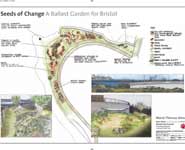Seeds of change is an ongoing investigation by artist Maria Thereza Alves into Bristol’s maritime history. In 2007, Maria Thereza found and photographed ballast sites around the River Avon and Bristol’s Harbourside. She then germinated seeds from those sites, in partnership with local community groups, and discovered a range of ballast flora. The next stage of this research is to have a permanent Ballast Seed Garden at the entrance to Bristol’s harbour.
Bristol University and Arnolfini are inviting members of the public to a free event to discuss the proposed Ballast Seed Garden for Bristol on Thursday 8 July at the University’s Botanic Garden in Stoke Bishop, Bristol.
A pilot Ballast Seed Garden, grown by the Botanic Garden, will be on display for people to see and comment on, alongside the artist’s proposal and plans.
Tours will take place throughout the afternoon, and there will be a discussion at 6 pm between the artist, Maria Thereza Alves; biologist, Professor Jane Memmott and environmental historian, Professor Peter Coates, both from Bristol University. Arnolfini Director, Tom Trevor, will chair the discussion.
Professor Simon Hiscock, Director of the Botanic Garden, said: “This event gives people the opportunity to have their say about the unique opportunity for a permanent Ballast Seed Garden for Bristol, and what that would mean for them.”
Maria Thereza Alves added: “Seeds of change is attempting to re-establish the histories of ballast flora and the individual histories to which these plants bear witnesses.”
This event forms part of a consultation process with communities about the proposal for a Ballast Seed Garden as a permanent public artwork, which Arnolfini have been developing with the help of Bristol City Council.
Seeds of Change: a Ballast Seed Garden for Bristol will be held on Thursday 8 July from 3.30 to 7.30 pm at the University of Bristol Botanic Garden, The Holmes, Stoke Park Road, Bristol BS9 1JB.
The event is free but booking is required. To reserve a ticket, contact Arnolfini Box Office on tel 0117 917 2300.

